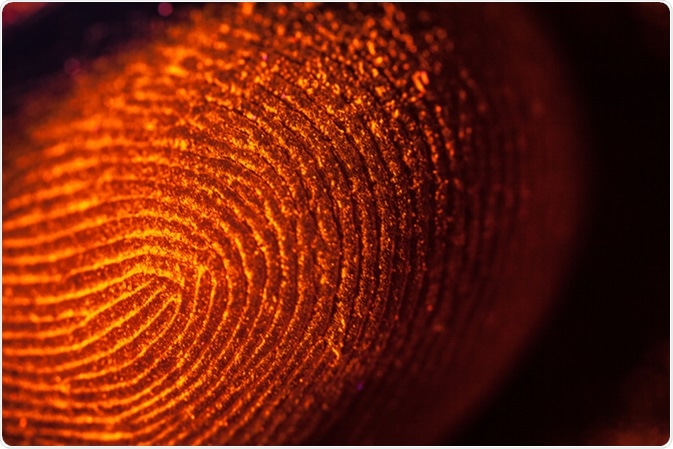Fingerprint drug tests analyze the sweat left behind in the grooves of a person’s fingerprint to determine whether that person has consumed various drugs, as trace amounts of particular analytes will be present in the sweat that can be used to infer this information.

Image Credit: Roman Seliutin/Shutterstock.com
Which drugs can be detected?
The platform is currently able to detect whether a person has consumed amphetamines, cannabis, cocaine, and opiates. Specialized reagents for the detection of other drugs are in development.
Different drugs are metabolized by the body in a variety of ways, generating a plethora of metabolites, some of which are excreted through the sweat glands.
Cocaine can passively diffuse through capillaries into sweat glands in its non-ionized form and can diffuse directly through the skin. The primary metabolite of cocaine is benzoylecgonine, but ecgonine and ethyl methyl ecgonine are also generated. The metabolizing of cocaine mainly takes place in the liver, where it undergoes hydrolytic ester cleavage to generate these molecules.
Cocaine and ethyl methyl ecgonine are detectable in the sweat as soon as 2 hours following consumption, whereas benzoylecgonine is detectable in 4 to 8 hours. After about 2 days, depending on the quantity of cocaine consumed, the metabolites will have been completely excreted and no longer be detectable in the sweat of an individual.
Similarly, amphetamines and methamphetamines are detectable in sweat around 2 hours following consumption and are completely metabolized and excreted from the body in less than 1 week. Amphetamines and their major metabolites, including 4-hydroxynorephedrine, are weakly basic low molecular weight compounds, and thus are able to diffuse through cell membranes relatively easily and can ultimately be found in sweat.
Tetrahydrocannabinol is the primary psychoactive component in cannabis and is also the major analyte detectable in the sweat of an individual following consumption for up to a week in most cases.
Opiates such as heroin produce the major metabolite 6-acetylmorphine, which is the main chemical found in sweat to evidence opioid use. Heroin is able to easily pass the blood-brain barrier as it is highly hydrophilic, where it undergoes deacetylation to 6-monoacetylmorphine followed by conversion to morphine, which causes the euphoric effects of the drug upon binding to opioid receptors in the brain.
Interestingly, this allows for differentiation between those who have consumed heroin and those who have consumed legally obtained alternatives such as morphine, codeine, or large quantities of poppy seeds, as 6-acetylmorphine is only generated in the metabolic pathway of heroin. Opiates too are generally detectable within 2 hours and up to a week in the sweat following consumption.
Introducing Fingerprint Drug Testing From Intelligent Fingerprinting
How are the metabolites detected?
A lateral flow assay is performed, utilizing fluorescently tagged probes to indicate that particular complementary molecules are present in a sample.
Several types of lateral flow assays exist with minor differences in their details of the operation. Generally, cellulose or paper-based material is used to support a mixed layer of molecules that will form complementary pairs with the analytes of interest in a sample. The liquid sample, in this case, sweat, is placed at one end of the assay test strip, which is then drawn through a membrane containing these molecules by an absorbent pad on the opposite end of the strip.
The molecules are tagged with a fluorescent probe, dye, or in some cases, plasmonic materials such as gold nanoparticles, which will then be clearly visible once they reach the test line. The test line is coated with antibodies that will only bind with the formed analyte-probe complex, demonstrating the presence of the analyte in question.
The most popular example of this type of lateral flow assay is the pregnancy test, which operates on these same principles by detecting analytes in the urine.
Further Reading